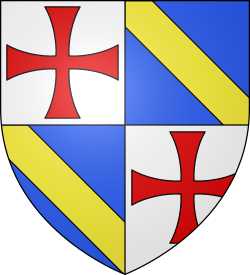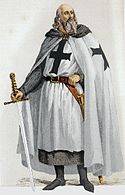Jacques de Molay
| Den här artikeln omfattas av Wikipedias policy om biografier. Den behöver fler källhänvisningar för att kunna verifieras. (2023-03) Åtgärda genom att lägga till pålitliga källor (gärna som fotnoter). Uppgifter utan källhänvisning kan ifrågasättas och tas bort utan att det behöver diskuteras på diskussionssidan. |
| Jacques de Molay | |
 | |
| Född | Molay[1], Frankrike |
|---|---|
| Död | 18 mars 1314[2] Paris[2] |
| Medborgare i | Tysk-romerska riket |
| Sysselsättning | Riddare |
| Befattning | |
| Grand Master of the Knights Templar (1292–1314)[3] | |
| Heraldiskt vapen | |
 | |
| Redigera Wikidata | |
Jacques de Molay, född 1240–1250[4], död 11 mars 1314[5][6][7][8][9] (vissa källor uppger också 18 mars[10]), var en av tempelherreordens stormästare.
Biografi
De Molay anslöt sig till orden 1265 och steg i graderna snabbt, han var bland annat kommendör i England. Efter den 22:a stormästarens död blev de Molay stormästare och han flyttade från England till Cypern. Han stannade på Cypern fram till 1307 då påven Clemens V kallade honom till Frankrike. Där blev de Molay dock arresterad av Filip IV av Frankrike. Filip utsatte honom för tortyr och han erkände sin skuld under tortyren. Skulden bestod däri, att han förnekat Kristus och trampat på korset.
Den 11 mars 1314[5] leddes Jacques de Molay ut för att offentligt erkänna sina och ordens synder. Han tog då tillbaka sina tidigare erkännanden och sade att hans enda skuld vara att han ljugit för att undkomma tortyren.
Jacques de Molay blev då förd till Île de la Cité i Seine där han brändes på bål tillsammans med Geoffrey de Charney, ordens kommendör i Normandie. De Molay förbannade Filip när han stod på bålet.
Referenser
- ^ Alain Demurger, Jacques de Molay: Le crépuscule des Templiers, Payot (förlag), 2014, s. 25, ISBN 978-2-228-91024-8.[källa från Wikidata]
- ^ [a b] läs online, www.newadvent.org .[källa från Wikidata]
- ^ läs online, Encyclopædia Britannica .[källa från Wikidata]
- ^ Alain Demurger (2015). ”1 Der junge Jacques de Molay 1250. Wo und wann wurde er geboren?” (på tyska). Der letzte Templer. Leben und Sterben des Grossmeisters Jacques de Molly. C.H.Beck. ISBN 978 3 406 68238 4. ”Das Geburtsjahr läßt sich also nicht eindeutig bestimmen. Wir beschränken uns auf eine ungefähre Schätzung. Demnach wurde Jacques de Molay im fünften Jahrzehnt des 13. Jahrhunderts in der Zeitspanne von 1244/45 bis 1248/49 geboren. ... Wenngleich zu dieser – wohl eher unbedeutenden – Frage noch nicht alles gesagt ist, würde ich für das Molay in der Haute-Saône optieren. ... Jacques de Molay stammt also aus einem vielleicht bedeutenden Adelsgeschlecht der Freigrafschaft Burgund und ist zwischen 1240 und 1250 geboren worden. Dieser räumliche und zeitliche Zusammenhang ist wichtig, denn die Freigrafschaft Burgund gehörte nicht zum französischen Königreich, sondern zum Deutschen Reich: Jacques de Molay war insofern kein Untertan des französischen Königs. ...”
- ^ [a b] Alain Demurger (2015). ”Nachwort zur dritten Auflage” (på tyska). Der letzte Templer. Leben und Sterben des Grossmeisters Jacques de Molly. C.H.Beck. ISBN 978 3 406 68238 4. ”Sein Scheiterhaufen wurde auf einer Seine-Insel unterhalb des Parks des Königspalasts in Höhe des heutigen Pont-Neuf errichtet, und nicht auf der Spitze des Vert-Galant, der im Mittelalter noch nicht existierte. Eine sorgfältige Studie der Chroniken, die von dem Ereignis berichteten, läßt den 11. März 1314 (den Tag vor Sankt Gregorius) als wahrscheinlicheres Datum der Vollstreckung des Urteils erscheinen als den 18. März, der üblicherweise angegeben wird (S. 269, 273).”
- ^ Alain Demurger (2018). ”14 The Council of Vienne and the Burning of Jaques de Molay (1311-1314)” (på engelska). The Persecution of the Templars Scandal, Torture, Trial. Profile Books. ISBN 978 1 78283 329 1. ”The date given in the chronicle of Guillaume de Nangis was the day after the Feast of Saint Gregory, or Monday 18 March (the feast day fell on 12 March); this is the date most often retained by historians of the Temple trial. But other chroniclers, such as Bernard Gui, have proposed the Monday before the Feast of Saint Gregory, or 11 March. We tend to agree with Bernard, since the chronology he proposes is most often very accurate.”
- ^ Philippe Josserand (2020-01-01). ”En quête de Jacques de Molay, dernier grand-maître de l’ordre du Temple” (på franska). Medievalista. http://journals.openedition.org/medievalista/2910. ”Le Temple, dès lors, était voué à disparaître, mais, devant Notre-Dame, le 11 mars 1314, Jacques de Molay, au prix de sa vie, revint sur ses aveux. ... Ce pari sur la mémoire et la postérité, au prix du sacrifice de sa vie, lui permit d’ouvrir une brèche et de s’extraire du piège dont depuis ses aveux, arrachés sous la torture, il était captif. Le sursaut de Notre-Dame, le 11 mars 1314, n’a donc rien d’un héroïsme vain.”.
- ^ Karl Hans Kluncker (1989). ”Die Templer: Geschichte und Geheimnis: Wolfgang Frommel zum Gedenken” (på tyska). Zeitschrift für Religions- und Geistesgeschichte (Brill) 41 (3): sid. 215-247. https://www.jstor.org/stable/23894240. ”Der letzte, zugleich der berühmteste, war Jacques de Molay, der am 11. März 1314 für seinen Orden den Tod des Märtyrers auf den Scheiterhaufen der Inquisition fand. — Zunächst jedoch wurden „die neuen Maccabäer", „die Athleten Christi" überall begeistert gefeiert und unterstützt. ... Am 11. März 1314 sollte der feierliche Schlußakt des Inquisitionsprozesses gegen den greisen Molay und die restlichen Ordensoberen stattfinden.”.
- ^ Elizabeth A. R. Brown (2015). ”Philip the Fair, Clement V, and the end of the Knights Templar: The execution of Jacques de Molay and Geoffroi de Charny in March”. Viator 47 (1): sid. 229-292. doi:. ”Abstract: This article revisits the generally accepted account of the execution of the Templar leaders Jacques de Molay and Geoffroi de Charny in March 1314, which derives from the continuation of the Latin Universal Chronicle of Guillaume de Nangis. Other contemporary chronicles, non-narrative evidence, and papal pronouncements cast light on the proceedings conducted by the three cardinal legates Clement V appointed to judge four Templar leaders in Paris, and suggest that the executions occurred on 11 rather than 18 March (the date given in the continuation) and, rather than being ordered by King Philip the Fair (as the continuation alleges), were the direct result of the cardinal legates’ decisions and actions.”.
- ^ Malcolm Barber (2006). ”Introduction” (på engelska). The Trial of the Templars (2). Cambridge University Press. ISBN 978-1-107-64576-9. ”The leaders eventually came before the papal representatives on 18 March 1314 and were sentenced to perpetual imprisonment. Hugh of Pairaud and Geoffrey of Gonneville, Preceptor of Aquitaine, accepted their fate in silence, but James of Molay and Geoffrey of Charney, Preceptor of Normandy, loudly protested their innocence and asserted that the Order was pure and holy. At once the king ordered that they be condemned as relapsed heretics and, on the same evening, they were burnt at the stake on the Ile des Javiaux in the Seine.”
Externa länkar
 Wikimedia Commons har media som rör Jacques de Molay.
Wikimedia Commons har media som rör Jacques de Molay.
Media som används på denna webbplats
Författare/Upphovsman: Tkgd2007, Licens: CC BY-SA 3.0
A new incarnation of Image:Question_book-3.svg, which was uploaded by user AzaToth. This file is available on the English version of Wikipedia under the filename en:Image:Question book-new.svg
Jacques de Molay


